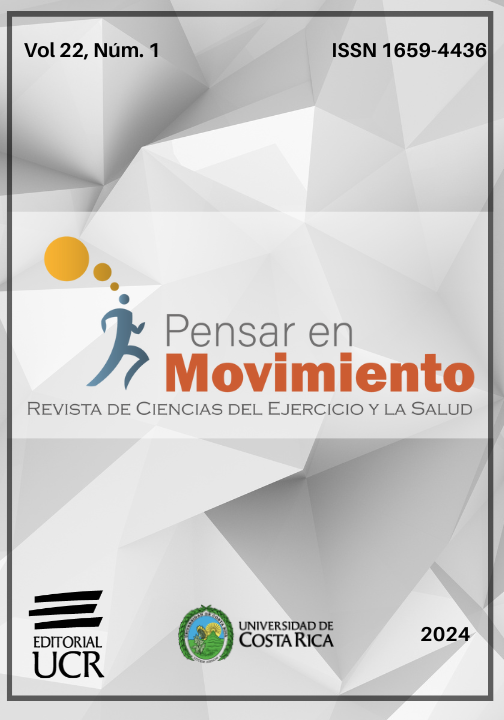Resumo
Reforçar a importância do papel das escolas na saúde diante das consequências indiretas da pandemia de covid-19 nos últimos anos, sob a perspectiva da promoção da saúde e da aquisição de hábitos saudáveis e de atividade física, é de suma importância. Portanto, convida-se a repensar as estratégias para lidar com as consequências da pandemia de covid-19, que resultou em novos números de sedentarismo, sobrepeso, obesidade e problemas de saúde mental, considerando, então, as características individuais dos escolares e os espaços educativos para a promoção de um estilo de vida saudável e a prática de atividade física e exercícios sem riscos à saúde.
Referências
Abarca-Sos A., Murillo B., Julián Clemente J.A., Zaragoza J., y Generelo, E. (2015). La Educación Física:¿ Una oportunidad para la promoción de la actividad física? Retos, 28. https://doi.org/10.47197/retos.v0i28.34946
Balanzá–Martínez, V., Atienza–Carbonell, B., Kapczinski, F., y De Boni, R. B. (2020). Lifestyle behaviours during the COVID‐19–time to connect. Acta Psychiatrica Scandinavica, 141(5), 399-400. https://doi.org/10.1111/acps.13177
Calabriano, V., Carrasco-Marín, F., Ulloa, N., Dávalos, A., Ruiz-Ros, o M. B., Martorell, M. (2022). Lifestyle modifications of chilean adolescents during the first COVID-19 confinement. Revista médica de Chile, 150(4), 483-492. http://dx.doi.org/10.4067/S0034-98872022000400483
Chen, P., Mao, L., Nassis, G. P., Harmer, P., Ainsworth, B. E., y Li, F. (2020). Returning Chinese school-aged children and adolescents to physical activity in the wake of COVID-19: actions and precautions. Journal of Sport and Health Science, 9(4), 322-324. https://doi.org/10.1016/j.jshs.2020.04.003
Curriculum Nacional. (2020). Priorización Curricular: Educación física y salud 1° básico a 4° medio. https://www.curriculumnacional.cl/docente/629/articles-177753_archivo_01.pdf
Gil‐Espinosa, F. J. (2020). La Covid-19: una carrera de fondo para avanzar en educación física. Journal of Physical Education and Human Movement, 2(2), 1-5. https://doi.org/10.24310/jpehmjpehmjpehm.v2i29849
Goldfield, G. S., Kenny, G. P., Prud’homme, D., Holčı́k, M., Alberga, A. S., Fahnestock, M., Cameron, J. D., Doucette, S., Hadjiyannakis, S., Tulloch, H., Tremblay, M. S., Walsh, J. J., Guérin, E., Gunnell, K. E., D’Angiulli, A., y Sigal, R. J. (2018). Effects of aerobic training, resistance training, or both on brain-derived neurotrophic factor in adolescents with obesity: the Hearty Randomized Controlled Trial. Physiology & Behavior, 191, 138-145. https://doi.org/10.1016/j.physbeh.2018.04.026
Hammami, A., Harrabi, B., Mohr, M., y Krustrup, P. (2020). Physical Activity and Coronavirus Disease 2019 (COVID-19): Specific recommendations for home-based physical training. Managing Sport and Leisure, 27(1-2), 26-31. https://doi.org/10.1080/23750472.2020.1757494
Harveson, A., Hannon, J. C., Brusseau, T. A., Podlog, L., Papadopoulos, C., Hall, M., y Celeste, E. (2019). Acute exercise and academic achievement in middle school students. International Journal of Environmental Research and Public Health, 16(19), 3527. https://doi.org/10.3390/ijerph16193527
López-Gil, J. F., Tremblay, M. S., y Brazo-Sayavera, J. (2021). Changes in Healthy Behaviors and Meeting 24-h Movement Guidelines in Spanish and Brazilian Preschoolers, Children and Adolescents during the COVID-19 Lockdown. Children, 8(2), 83. https://doi.org/10.3390/children8020083
McCambridge, T. M., y Stricker, P. R. (2008). Strength training by children and adolescents. Pediatrics, 121(4), 835-840. https://doi.org/10.1542/peds.2007-3790
Monda, V., Sessa, F., Maria, R., Carotenuto, M., Marsala, G., Monda, M., Cambria, M. T., Astuto, M., Distefano, A., y Messina, G. (2020). Aerobic exercise and Metabolic syndrome: the role of sympathetic activity and the redox system. Diabetes, Metabolic Syndrome and Obesity: Targets and Therapy, 13, 2433-2442. https://doi.org/10.2147/dmso.s257687
Phillips, C. (2017). Brain-Derived neurotrophic factor, depression, and physical activity: making the neuroplastic connection. Neural Plasticity in Mood Disorders, 2017, 1-17. https://doi.org/10.1155/2017/7260130
Pietrobelli, A., Pecoraro, L., Ferruzzi, A., Heo, M., Faith, M., Zoller, T., Antoniazzi, F., Piacentini, G., Fearnbach, N., y Heymsfield, S. B. (2020). Effects of COVID‐19 Lockdown on Lifestyle Behaviors in Children with Obesity Living in Verona, Italy: A Longitudinal Study. Obesity, 28(8), 1382-1385. https://doi.org/10.1002/oby.22861
Ramsbottom, R., Currie, J. M. S., y Gilder, M. (2010). Relationships between components of physical activity, cardiorespiratory fitness, cardiac autonomic health, and brain-derived neurotrophic factor. Journal of Sports Sciences, 28(8), 843-849. https://doi.org/10.1080/02640411003702686
Reyes-Olavarría, D., Latorre-Román, P. Á., Guzmán-Guzmán, I. P., Jerez-Mayorga, D., Caamaño-Navarrete, F., y Delgado-Floody, P. (2020). Positive and negative changes in food habits, physical activity patterns, and weight status during COVID-19 confinement: associated factors in the Chilean population. International Journal of Environmental Research and Public Health, 17(15), 5431. https://pubmed.ncbi.nlm.nih.gov/32731509/
Sormunen, M., Lattke, L. S., Leksy, K., Dadaczynski, K., Sakellari, E., Velasco, V., Borzucka-Sitkiewicz, K., Miranda-Velasco, M. J., Rabaglietti, E., y Rosário, R. (2022). Health Promoting Schools and COVID-19: Preparing for the future. Scandinavian Journal of Public Health, 50(6), 655-659. https://doi.org/10.1177/14034948221091155
UNICEF. (2021). Efectos de la pandemia por la COVID-19 en la nutrición y actividad física de adolescentes y jóvenes. https://www.unicef.org/lac/efectos-de-la-pandemia-por-la-covid-19-en-la-nutricion-y-actividad-fisica-de-adolescentes-y-jovenes
Viner, R., Russell, S., Croker, H., Packer, J., Ward, J., Stansfield, C., Mytton, O., Bonell, C., y Booy, R. (2020). School closure and management practices during coronavirus outbreaks including COVID-19: A Rapid Systematic review. The Lancet Child & Adolescent Health, 4(5), 397-404. https://doi.org/10.1016/s2352-4642(20)30095-x
Yu, C., McManus, A. M., So, H., Chook, P., Au, C. T., Li, A. M., Kam, J. T., So, R., Lam, C. W., Chan, I. H., y Sung, R. Y. T. (2016). Effects of resistance training on cardiovascular health in non-obese active adolescents. World Journal of Clinical Pediatrics, 5(3), 293-300. https://www.ncbi.nlm.nih.gov/pmc/articles/PMC4978622/
Yüksel, H. S., Şahin, F. N., Maksimović, N., Drid, P., y Bianco, A. (2020). School-Based Intervention Programs for Preventing Obesity and Promoting Physical Activity and Fitness: A Systematic review. International Journal of Environmental Research and Public Health, 17(1), 347. https://doi.org/10.3390/ijerph17010347
##plugins.facebook.comentarios##

Este trabalho está licenciado sob uma licença Creative Commons Attribution-NonCommercial-ShareAlike 4.0 International License.
Copyright (c) 2024 Jairo Azócar-Gallardo, Jorge Carrizo-Largo, Alex Ojeda-Aravena



